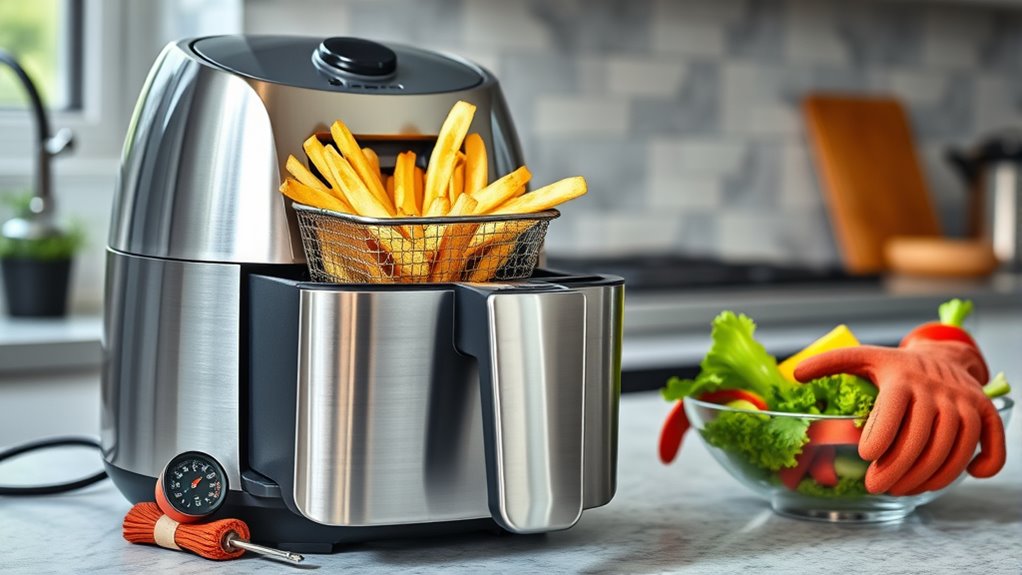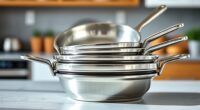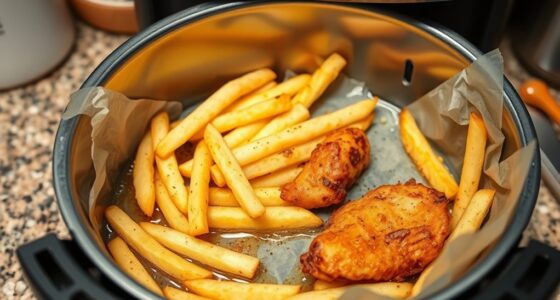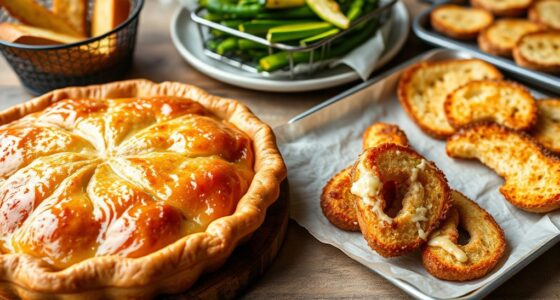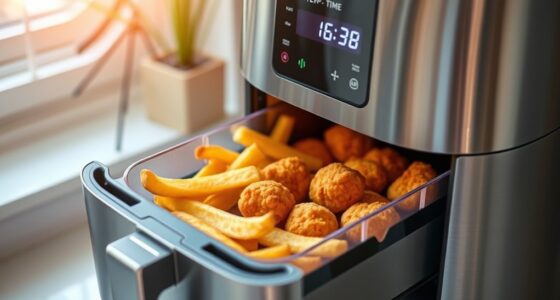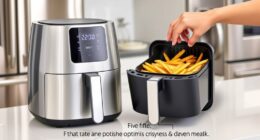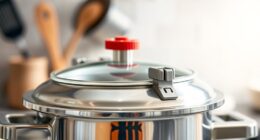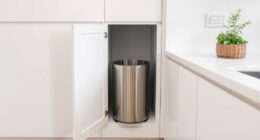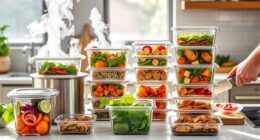To guarantee safe use of your air fryer, always handle hot parts carefully with oven mitts, open lids slowly to avoid steam burns, and keep the appliance cooled before cleaning. Stay mindful of fire hazards by keeping flammable materials away, never block air vents, and regularly inspect cords for damage. Proper placement on flat, heat-resistant surfaces and correct food loading help prevent accidents. Keep safety tips in mind—more guidance awaits if you look further.
Key Takeaways
- Use oven mitts and tongs to handle hot surfaces and prevent burns or scalds during and after cooking.
- Keep flammable objects away and ensure proper ventilation to reduce fire and overheating risks.
- Maintain at least 4 inches of space around the air fryer and place it on heat-resistant, flat surfaces.
- Do not overload the basket; follow capacity guidelines to ensure even cooking and prevent safety hazards.
- Regularly inspect cords, clean removable parts, and monitor cooking times with thermometers or digital tools.
Recognizing and Avoiding Burns and Scalds
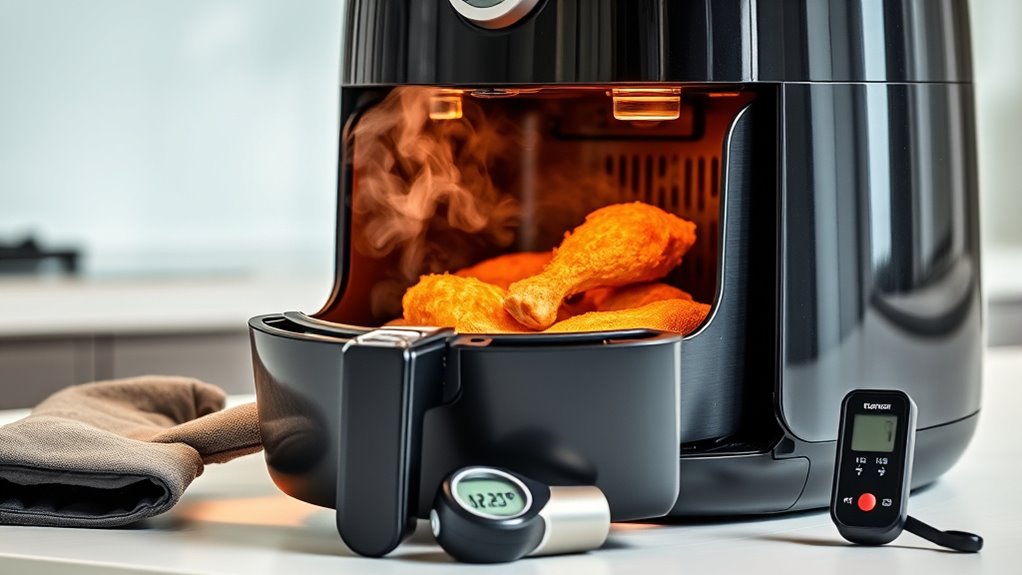
Because an air fryer operates at high temperatures, burns and scalds are common risks if you’re not careful. Hot surface hazards can cause serious burns if you touch the exterior or the basket immediately after cooking. Always use oven mitts or tongs to handle hot parts, and avoid placing your hands near the heating element. Steam burns are another danger, especially when opening the lid or basket too quickly. The steam released can cause painful injuries if you’re not cautious. To prevent these burns, let the air fryer cool down slightly before opening, and always open the basket slowly to allow steam to escape safely. Staying alert and handling the appliance carefully minimizes your risk of burns and scalds. Additionally, understanding the proper maintenance of your air fryer can help prevent malfunctions that could lead to safety hazards.
Preventing Fire Risks Associated With Air Fryers
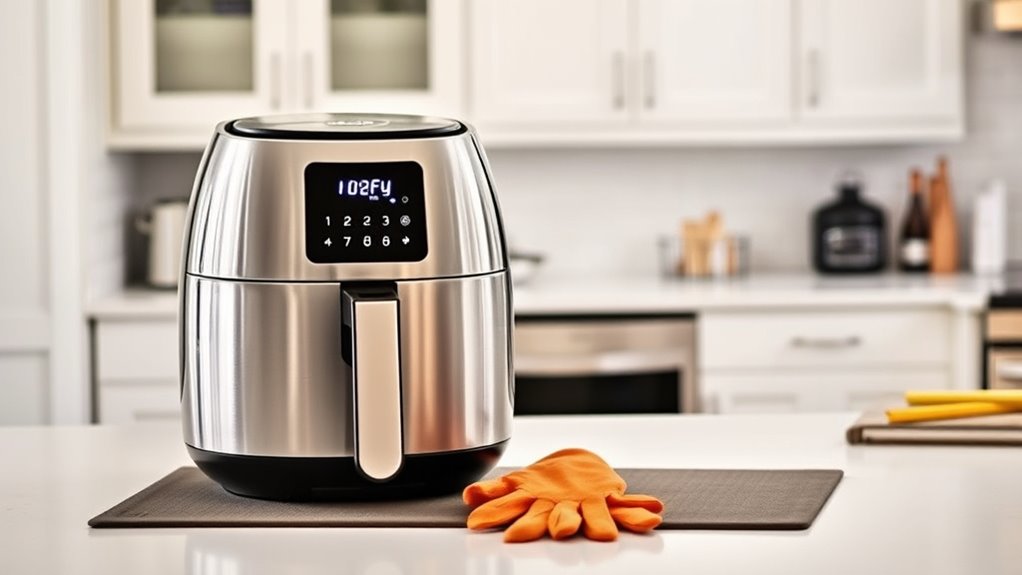
While taking steps to prevent burns and scalds is essential, it’s equally important to reduce the risk of fire hazards when using your air fryer. Fire risks can come from flammable materials and electrical hazards. To stay safe:
- Keep flammable materials, like paper towels and plastic wraps, away from the air fryer.
- Never block air vents or obstruct airflow, which can cause overheating.
- Regularly inspect the power cord and plug for damage and avoid overloading outlets.
- Follow the manufacturer’s guidelines for proper cleaning and maintenance to prevent electrical malfunctions.
- Ensuring proper ventilation can help prevent overheating and reduce fire risks.
Ensuring Electrical Safety During Use and Maintenance
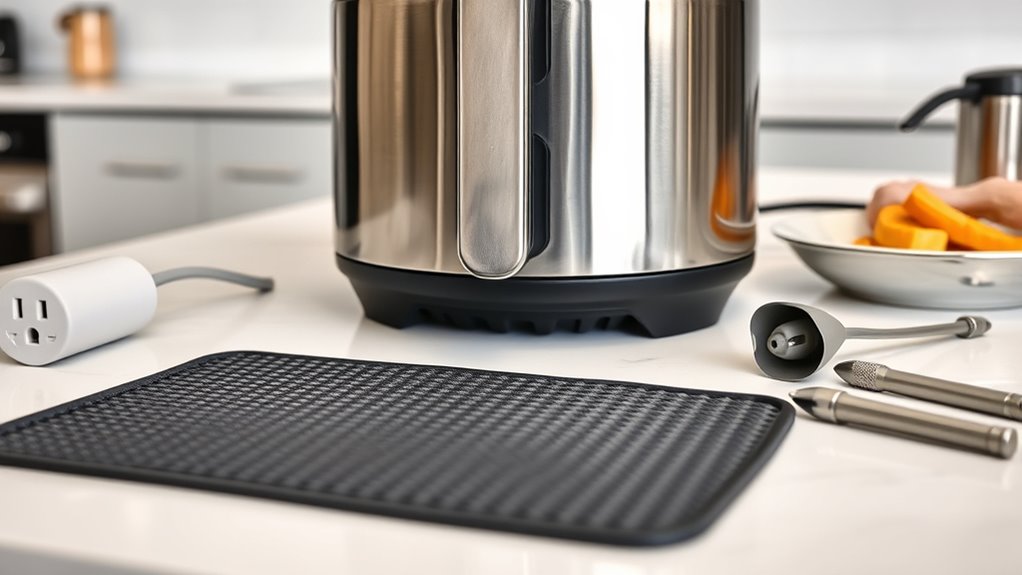
To guarantee electrical safety during use and maintenance, you need to handle your air fryer’s electrical components carefully and follow proper procedures. Start by inspecting the power cord regularly for damage, and never use it if frayed or cracked. Practice good electrical cord management by keeping the cord away from hot surfaces and water to prevent hazards. Proper grounding techniques are essential; always plug your air fryer into a grounded outlet to reduce the risk of electric shock. Avoid overloading outlets or using adapters that could compromise grounding. When cleaning or servicing, unplug the appliance first. Keep the plug dry and avoid touching it with wet hands. Following these safety tips helps minimize electrical risks and keeps your air fryer functioning safely. Unexpected malfunctions can occur if electrical issues are ignored, so regular maintenance is key.
Proper Placement and Ventilation for Safe Operation
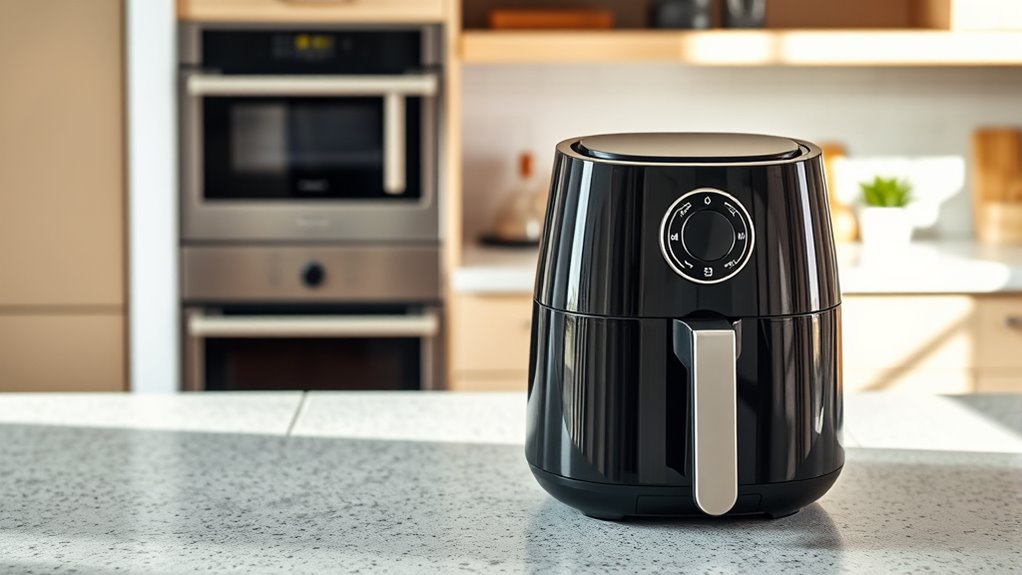
Make sure your air fryer has plenty of space around it to operate safely. Keep it in a well-ventilated area to prevent overheating and allow steam to escape. Avoid overcrowding the area, so air can circulate freely and reduce fire hazards. Additionally, ensuring proper placement can improve performance, similar to how performance upgrades enhance vehicle handling and efficiency.
Clear Space Around Unit
Ensuring there is enough space around your air fryer is essential for safe operation. Proper space management prevents overheating and allows heat to dissipate, reducing fire risk. Make sure you maintain adequate countertop clearance to avoid clutter and ensure airflow. Here are four key points:
- Leave at least 4 inches of space on all sides of the unit.
- Keep the top of the air fryer clear for heat escape.
- Avoid placing it near walls or cabinets that could block vents.
- Ensure the area around the appliance is free of flammable objects and clutter.
- Regularly check that your ventilation system remains unobstructed to maintain optimal airflow and safety.
Adequate Ventilation Needed
Proper placement of your air fryer is crucial for effective ventilation and safe operation. Ensure your unit is positioned on a flat, heat-resistant surface with plenty of space around it. Good airflow helps prevent overheating and reduces fire risks. Many air fryers have built-in air fryer filters that trap grease and odors, but these work best when air circulates freely. Use ventilation fans or exhaust hoods if cooking in enclosed spaces, as they help remove steam and airborne particles. Avoid placing your air fryer under cabinets or near walls that block airflow, as this can cause heat buildup. Proper ventilation not only protects your appliance but also keeps your kitchen safe and odor-free. Adequate ventilation practices are essential for maintaining the longevity and safety of your air fryer. Remember, good airflow is key to safe, efficient air frying.
Avoid Overcrowding Area
To prevent overheating and guarantee safe operation, it’s vital to avoid overcrowding your air fryer with too much food or placing it too close to other objects. Proper placement ensures good airflow and reduces fire risks. Maintain adequate space around your air fryer during use, and avoid blocking vents. When storing your air fryer, keep it in a well-ventilated area away from heat sources. Incorporate regular cleaning routines to prevent grease buildup that can affect ventilation. Also, check that the area around your air fryer remains clear after cleaning to promote safe operation. Ensuring proper airflow circulation is essential for preventing overheating and maintaining the longevity of your appliance.
Handling and Cleaning to Minimize Hazards

Handling and cleaning your air fryer carefully is essential to prevent accidents and maintain its safety. Always follow proper cleaning protocols to avoid grease buildup and potential fires. Use handling tools like tongs or oven mitts when removing hot components to prevent burns. After cooking, unplug the appliance before cleaning to avoid electric shocks. Regularly check for food debris and wipe down the interior and exterior with a damp cloth. Avoid abrasive cleaners that could damage surfaces.
| Handling Tools | Cleaning Tips |
|---|---|
| Tongs, oven mitts | Use non-abrasive cloths for wiping surfaces |
| Heat-resistant gloves | Ensure the unit is cooled before cleaning |
| Scraper (if needed) | Clean removable parts thoroughly |
| Slotted spoon | Avoid soaking electrical parts |
| Brush | Follow manufacturer’s cleaning protocols |
Safe Usage Tips for Different Food Types and Quantities

When cooking different food types and quantities, it’s important to adjust your times to guarantee even results. You should also use appropriate basket amounts to prevent overcrowding and uneven cooking. Keep a close eye on how you arrange your food so everything cooks safely and thoroughly. Incorporating organized space can help you better manage your food placement and ensure consistent results.
Adjust Cooking Times Accordingly
Since different foods and quantities require varying cooking durations, it’s important to modify your air fryer times accordingly. Always adjust based on food thickness and size for even cooking. Here are some tips to help you:
- Check food frequently and start with shorter times, then add more if needed.
- Thinner cuts cook faster, so reduce the time to prevent overcooking.
- Larger quantities may need extra time; stagger additions when possible.
- Use a food thermometer to ensure proper doneness, especially when adjusting times.
- Incorporate digital literacy in your cooking routines by utilizing smart appliances or apps to monitor cooking times and temperatures.
Use Appropriate Basket Quantities
Using the right amount of food in your air fryer basket is essential for safe and effective cooking. Overloading can block airflow, leading to uneven cooking or potential hazards. To practice proper portion control, always respect your air fryer’s basket capacity. For ideal results, consider the food type and quantity, ensuring enough space for hot air to circulate. Here’s a quick guide:
| Food Type | Recommended Quantity | Basket Capacity Reminder |
|---|---|---|
| Frozen fries | 1-2 cups | Don’t exceed half the basket |
| Chicken pieces | 4-6 pieces | Leave room for airflow |
| Vegetables | 1-2 cups | Use small batches |
| Fish fillets | 2-3 pieces | Avoid overcrowding |
Proper portion control prevents safety issues and ensures delicious, evenly cooked meals. Additionally, paying attention to safe usage tips helps prevent common hazards associated with air fryer operation.
Monitor Food Placement Carefully
Have you ever noticed uneven cooking or food remnants stuck to the basket? That’s often due to poor food placement. To guarantee even cooking, pay close attention to food arrangement and container placement inside the basket. Here are some tips:
- Spread food in a single layer to promote proper air circulation.
- Avoid overcrowding; leave space between items for airflow.
- Use appropriate-sized baskets or trays based on food quantity.
- Regularly shake or turn food during cooking to maintain even heat.
- Refer to best laundry detergents and their recommendations for optimal cleaning results.
Frequently Asked Questions
How Often Should I Inspect My Air Fryer for Safety Issues?
You should perform regular maintenance and safety inspections on your air fryer every 1 to 3 months. Check the power cord for damage, ensure vents are clear, and inspect the interior for any signs of wear or residue buildup. Regular maintenance helps prevent hazards and keeps your appliance functioning safely. If you notice any issues during inspections, address them immediately to avoid potential accidents or damage.
What Are the Signs of a Damaged Power Cord or Plug?
You should regularly check your air fryer’s power cord damage and perform a thorough plug inspection. Look for frayed wires, cracks, or burn marks on the cord, and make sure the plug fits snugly without looseness. If you notice any signs of damage, stop using the appliance immediately. Damaged power cords and faulty plugs pose serious safety risks, so addressing these issues promptly helps prevent electrical shocks or fires.
Can Using Metal Utensils Cause Damage or Hazards?
Using metal utensils with your air fryer can pose metal utensil hazards, especially if they scratch or damage the non-stick coating. Always check cookware compatibility before using metal tools; plastic or silicone utensils are safer options. Metal can cause sparks or damage internal components, increasing safety risks. To protect your appliance and ensure safe operation, stick to recommended utensils and avoid metal unless specified as safe for your air fryer.
Is It Safe to Leave the Air Fryer Unattended During Cooking?
Imagine your air fryer as a vigilant guardian, quietly working while you focus elsewhere. While it’s generally safe to leave it unattended during cooking, you should prioritize proper air fryer maintenance and follow cooking safety guidelines. Always stay nearby if you’re unsure, and avoid leaving it alone for extended periods. Keeping an eye on your appliance helps prevent accidents, ensuring your cooking remains safe and your food turns out perfectly crispy.
How Do I Prevent Cross-Contamination When Cooking Different Foods?
To prevent cross-contamination, you should prioritize food separation and follow proper cleaning protocols. Always use separate utensils and plates for raw and cooked foods, and avoid mixing different ingredients directly in the fryer. Clean the air fryer thoroughly between uses, especially if you’re cooking different types of food. This approach minimizes bacteria transfer, keeping your meals safe and preventing foodborne illnesses.
Conclusion
By following these safety tips, you can enjoy your air fryer without worry. Some might think safety precautions slow down cooking or are unnecessary, but staying vigilant prevents accidents and keeps your kitchen safe. With a little care, you’ll savor delicious, healthy meals confidently and safely. Remember, taking a few extra moments to guarantee proper use can make all the difference—so don’t skip safety; it’s the key to trouble-free cooking.
